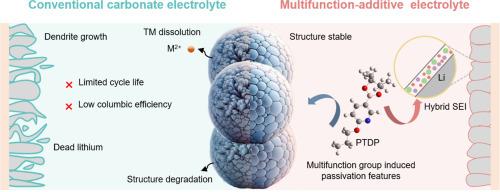通过多功能添加剂在具有超高镍阴极的4.6 V锂金属电池中实现480 Wh kg⁻1
IF 20.2
1区 材料科学
Q1 CHEMISTRY, PHYSICAL
引用次数: 0
摘要
高镍层状氧化物(如LiNi0.90Co0.05Mn0.05O2, NCM9055)与锂金属阳极结合,有望用于下一代高能量密度电池,但其实际实施受到关键界面不稳定性的阻碍,包括锂枝晶生长、高压下电解质分解(≥4.5 V vs. Li/Li +)和过渡金属溶解。为了解决这些同时存在的挑战,我们引入了2-丙氧基-5-(4,4,5,5-四甲基-1,3,2-二氧硼酸-2-基)吡啶(PTDP)作为一种新型多功能电解质添加剂,用于双电极稳定。PTDP创新的分子结构集成了一个吡啶环,它与过渡金属螯合以抑制溶解,硼酯基作为阴离子受体,增强Li⁺的传输和均质通量。密度功能理论计算表明,PTDP优先分解形成坚固的LiF/Li3N/LiBO2杂化界面,具有极高的Li⁺吸附能(-6.70 eV),有利于Li⁺均匀沉积、加速动力学和有效抑制枝晶。同时,ptdp衍生的阴极电解质界面在循环过程中保持了NCM9055阴极的结构完整性。因此,1.5 Ah的NCM9055||锂袋电池使用仅含有0.5 wt% PTDP添加剂的碳酸基电解质表现出优异的循环稳定性,在4.6 V下60次循环后保持95.8%的容量,并提供480 Wh kg⁻1的高能量密度,明显优于无添加剂的锂袋电池。本文章由计算机程序翻译,如有差异,请以英文原文为准。

Achieving 480 Wh kg⁻1 in 4.6 V Lithium Metal Batteries with Ultrahigh-Nickel Cathodes via a Multifunctional Additive
High-nickel layered oxides (e.g., LiNi0.90Co0.05Mn0.05O2, NCM9055) coupled with lithium metal anodes are promising for next-generation high-energy-density batteries, yet their practical implementation is hindered by critical interfacial instabilities, including lithium dendrite growth, electrolyte decomposition at high voltages (≥ 4.5 V vs. Li/Li⁺), and transition metal dissolution. To address these concurrent challenges, we introduce 2-propoxy-5-(4,4,5,5-tetramethyl-1,3,2-dioxaborolan-2-yl)pyridine (PTDP) as a novel multifunctional electrolyte additive designed for dual-electrode stabilization. The innovative molecular architecture of PTDP integrates a pyridine ring, which chelates transition metals to inhibit dissolution, with a boronic ester group functioning as an anion receptor to enhance Li⁺ transport and homogenize flux. Density functional theory calculations reveal that PTDP preferentially decomposes to form a robust LiF/Li3N/LiBO2 hybrid interphase exhibits an exceptionally high Li⁺ adsorption energy (–6.70 eV), facilitating uniform Li⁺ deposition, accelerated kinetics, and effective dendrite suppression. Concurrently, the PTDP-derived cathode electrolyte interphase preserves the structural integrity of the NCM9055 cathode during cycling. As a result, a 1.5 Ah NCM9055||Li pouch cell employing a carbonate-based electrolyte with only 0.5 wt% PTDP additive demonstrates exceptional cycling stability, retaining 95.8% of its capacity after 60 cycles at 4.6 V, and delivering a high energy density of 480 Wh kg⁻1, significantly outperforming additive-free counterpart.
求助全文
通过发布文献求助,成功后即可免费获取论文全文。
去求助
来源期刊

Energy Storage Materials
Materials Science-General Materials Science
CiteScore
33.00
自引率
5.90%
发文量
652
审稿时长
27 days
期刊介绍:
Energy Storage Materials is a global interdisciplinary journal dedicated to sharing scientific and technological advancements in materials and devices for advanced energy storage and related energy conversion, such as in metal-O2 batteries. The journal features comprehensive research articles, including full papers and short communications, as well as authoritative feature articles and reviews by leading experts in the field.
Energy Storage Materials covers a wide range of topics, including the synthesis, fabrication, structure, properties, performance, and technological applications of energy storage materials. Additionally, the journal explores strategies, policies, and developments in the field of energy storage materials and devices for sustainable energy.
Published papers are selected based on their scientific and technological significance, their ability to provide valuable new knowledge, and their relevance to the international research community.
 求助内容:
求助内容: 应助结果提醒方式:
应助结果提醒方式:


